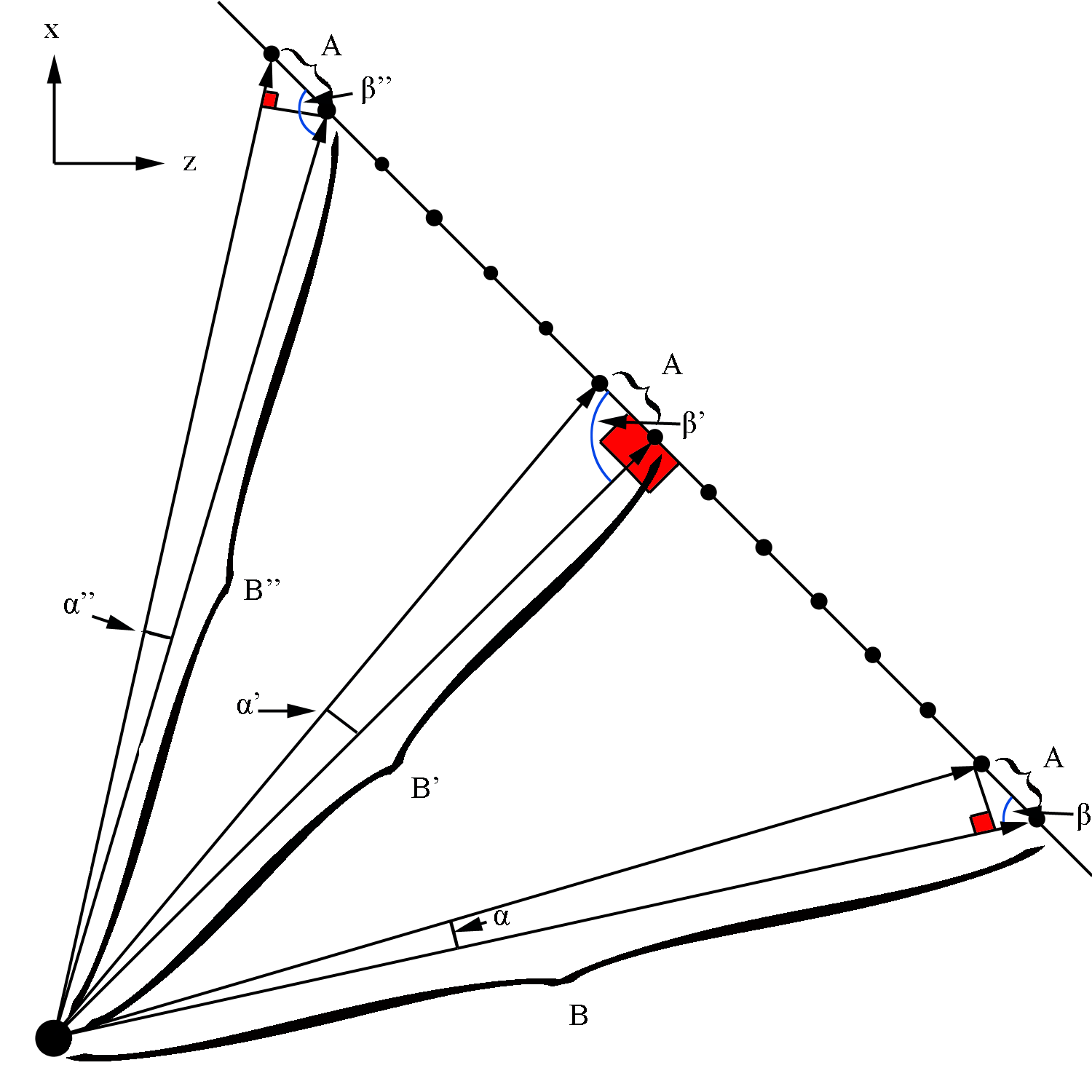DC Super Layer 1:Layer 1
DC Super Layer 1:Layer 1
From the ced simulations
| Coordinates(cm) | Layer 1 | Layer 2 | Layer 3 | Layer 4 | Layer 5 | Layer 6 |
|---|---|---|---|---|---|---|
| 1.22 | 1.22 | 1.22 | 1.22 | 1.21 | 1.22 | |
| 0.00 | 0.00 | 0.00 | 0.00 | 0.00 | 0.00 | |
| .55 | .56 | .57 | .57 | .57 | .57 |
While the wire placement is off, the difference in x and z position is matched by the calculated values. Using the geometric construction for determining angle theta to wire 2:
This equation can be solved for a hypothetical wire 0, which will allow the wire number to be the multiplicative factor for the change from the starting position.
where
Using Mathematica, a series expansion about n=0 can be found:
In[2]:= Series[ArcTan[(20.9972+1.212 n)/(243.1431-0.5652 n)],{n,0,4}]
Out[2]= 0.0861437+0.00514708 n+9.67686*10^-6 n^2-2.72596*10^-8 n^3-2.22159*10^-10 n^4+O[n]^5
This expression will find the angle theta in radians given the wire number. To convert from radians to degrees, we can multiply by 180 and divide by Pi.
In[3]:= 180(0.08614365821719583`+0.005147076698801422` n+9.676859262994711`*^-6 n^2-2.7259639443492433`*^-8 n^3-2.2215881081233252`*^-10 n^4+O[n]^5)/3.14159265359 Out[3]= 4.93567+0.294906 n+0.000554443 n^2-1.56186*10^-6 n^3-1.27288*10^-8 n^4+O[n]^5
This tells us that the expression for theta will follow a function that comes from a series expansion. Using Mathematica, a line can be fitted to the data collected on the wire number to angle theta correspondence.
| Wire Number | Layer 1 |
|---|---|
| 1 | 5.23 |
| 2 | 5.53 |
| 77 | 29.80 |
| 78 | 30.13 |
| 79 | 30.46 |
| 110 | 40.45 |
| 111 | 40.76 |
| 112 | 41.07 |
Declaring the data set:
In[4]:= data1={{1,5.23},{2,5.53},{77,29.80},{78,30.13},{79,30.46},{110,40.45},{111,40.76},{112,41.07}}
Out[4]= {{1,5.23},{2,5.53},{77,29.8},{78,30.13},{79,30.46},{110,40.45},{111,40.76},{112,41.07}}
Testing for a linear fit:
In[5]:= line1=Fit[data1,{1,n},n]
Out[5]= 4.90443 +0.323148 n
Examining the range limits for the angle theta for layer 1:
Taking the difference of the upper and lower limits in theta,
Dividing by the change in wire numbers (112-1=111), we find
This would imply that if the wires were evenly placed, their change in angle theta would increase by the factor of .323 degrees for each increase in wire number, starting obviously with wire 1 at 5.23 degrees. In addition, this implies that the bin spacing for each wire would be around .323 degrees in width.
Checking this, we can find the difference between wires 1 and 2,
Similarly, finding the difference between wires 111 and 112,
These differing values show that the bin width is not uniform in length, therefore a first order, linear fit, will not suffice. The change in bin size, with respect to the angle theta covered, is due to the tilt of the wire plane.

Testing for a quadratic fit:
In[6]:= quad1=Fit[data1,{1,n,n^2},n]
Out[6]= 4.89326 +0.324556 n-0.0000129154 n^2
The quadratic fit does not work since it's first derivative
does not give the same spacing between low and high values of n as seen in the calculated data. The coefficient near the first order will have to smaller than .31 to find a correlation that would agree.
Testing for a polynomial of degree 3 fit:
In[7]:= polynomial1=Fit[data1,{1,n,n^2,n^3},n]
Out[7]= 4.93253 +0.297371 n+0.000566298 n^2-3.04016*10^-6 n^3
This fit best matches the data found in the calculated data
As discussed earlier, taking the 1st derivative of this function will give us the spacing of the bins as a function of wire number.
The derivative of this function then will tell us where the bin spacing is at a minimum and a maximum.
This is near the midpoint of the plane as seen in the geometry file.